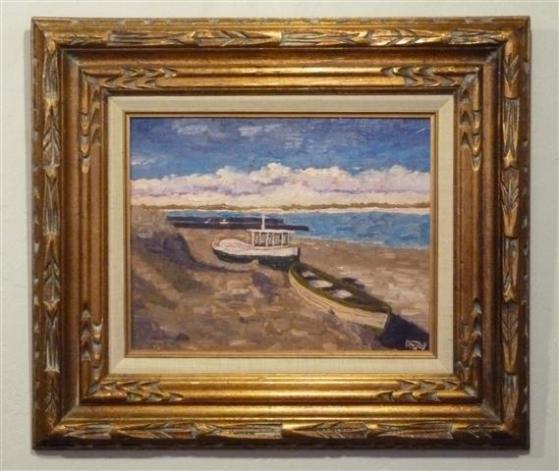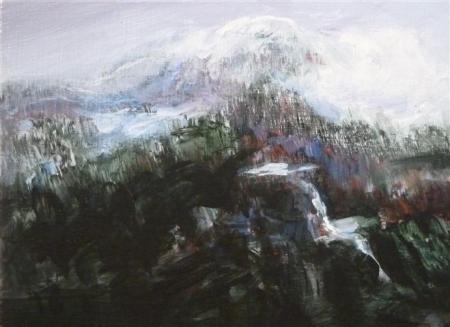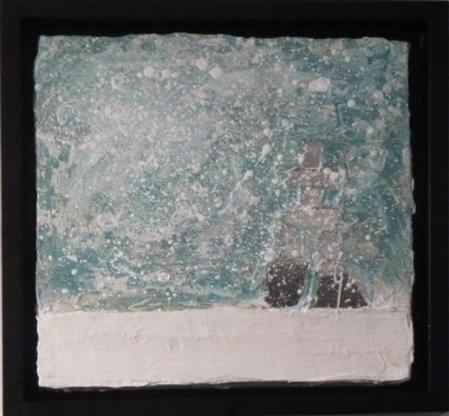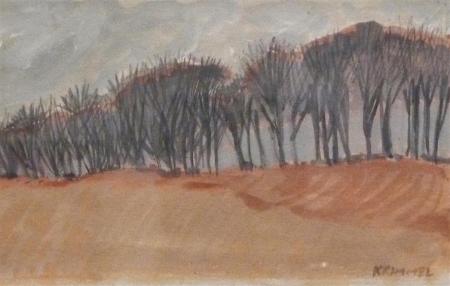Low Tide, Bob Wakefield, 11×14. oil on canvas
Prada, Bob Wakefield, Oil on Canvas, 14×18 inches
Normally, I wouldn’t post a painting complete with frame, but these two paintings just beg for frame recognition. The paintings by themselves would just not be the same.
Bob Wakefield is one of about 20 artists in the Fort Gallery artists collective in Fort Langley, B.C. The show Small Wonder! is the pre-Christmas, salons-style exhibit that allows the artists to bring out their non-series paintings, their small works, trials, sketches, etc. They are beautiful and they are affordable.
Wakefield was originally a student of Susan Falk, who is also with the gallery, and they work in thick impasto and expressionist style. Falk’s is showing some farm-related imagery – a painting of a red barn, a large drawing of a sunflower, and a painting of her beautiful little iris-rimmed pond that is just big enough for a small row boat and a gaggle of geese. Pond Study is loose and dramatic with autumn colours contrasting with an ultramarine blue.
Pond Study, Susan Falk. 24×12, oil on canvas
Two paintings from the series “From the bus: Coquihalla“, Veronica Plewman, each 6×8 inches, acrylic on board.
Plewman is showing 6 paintings from the series, “From the Bus: Coquihalla”. The paintings describe the area near Merritt and Kamloops in British Columbia where the highway cuts through the mountain pass on Highway 5. Plewman has captured the wonderful quality of colour that sings through a snowy landscape where, to the unschooled eye, one might be excused to think that there was just white and dark. She paints the blues, rusts, ceruleans and yellow greens that sparkle through when a bit of winter sunshine illuminates the hills. In these small paintings, she manages to describe the mightiness of the mountains and the detail of soft fog captured between the hills or a stand of bare alder with their raw umber branches. These are simply jewels of craftsmanship and vision.
Search, Bloom, Shine, and Drift, four prints by Edith Krause, , approximately 9×12 or 10×10 inches.
Several of Edith Krause’s small prints from “The Butterfly Effect” series are available in the show. I wrote about them recently so if you would like to see samples of those, go looking back a post or two. Search, Bloom Shine and Drift are new works to the gallery and have quite a different feel to them. Krause creates prints with great attention not only to the inherent ecological message but also to the texture and surface qualities of her work. She pays great attention to finishing detail. These works are simply perfect in craftsmanship.
“Inukshuk” Pat Barker, Acrylic and Mirror on board. Approximately 8×8 inches.
With Inukshuk, Pat Barker gives us a preview of her upcoming show. She experiments with materials and includes bits of mirror in her design, enhancing the feeling of ice and snow.
Carolina Poplars, France, Kristin Krimmel, gouache, 6×8 inches approx,
There are a number of works by artist Kristin Krimmel. This early gouache of hers describes the lines of trees along the roadside in France in the Department of the Marne. Another landscape she offers is a watercolour of a farmhouse near Montpellier. It’s inspiration in style is an adaptation of the pointillists method or working. By overlapping small strokes of pure colour she blends and nuances the image to represent the special heat and light qualities of the Languedoc region on the Mediterranean.
The Mas, Kristin Krimmel, watercolour on Arches paper
The surrealist of the group, Olga Khodyreva has contributed this fluid image:
Drama, Olga Khodyreva, Gouache and ink on Paper. 12×12 inches.
It’s reminiscent of Joan Miro, Alexander Calder and Picasso with it’s tumbling figures.
Winter wandering, Jennifer Chew, 8×10, Velum and charcoal on wood panel.
Winter wandering describes fine branches emerging from snow. There is a delicate quality of calligraphy in this finely composed drawing.
Salmon Glacier, Fiona Howath, 11 x 14, Silver Gelatin photograph
Fallen Giant, Fiona Howath, Silver gelatin photograph, 11 x 14
Fiona Howath is an upcoming photographer whose work, in this exhibition, focuses on the natural landscape. She has crisp focus and captures exceptional lighting. Detail is as important in the foreground as it is in the back. I particularly like the feathery quality of the ferns in Fallen Giant and in Salmon Glacier, I find the light/dark composition is excellent with the cloud, white above the mountain, casting dark on its slopes and brilliant sunshine delineating the character of the geological formation.
There are lots of paintings from each of the artists. As one is sold, it goes away with the purchaser and another gets put up.
I encourage you to go see the show and maybe even treat yourself to a painting. They are reasonably priced and there is lots of variety. Also there are several smaller items – greeting cards by four or five of the artists, fused glass tree ornaments (Judy Jones), chap books and other small gift items.
Also featured in this show: Richard Bond, Lucy Adams, Doris Auxier, Fiona Howarth, Dorthe Eisenhardt, Judy Jones.
The location is 9048 Glover Road, Fort Langley, B.C. The gallery is open noon to 5 p.m., Wednesday through Sunday, and the show closes Sunday December 23rd.
Don’t forget to check out the web-site too:


































